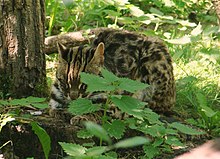
Prionailurus bengalensis

The leopard cat (Prionailurus bengalensis) is a small wild cat native to continental South, Southeast and East Asia. Since 2002 it has been listed as Least Concern on the IUCN Red List as it is widely distributed although threatened by habitat loss and hunting in parts of its range. Historically, the leopard cat of continental Asia was considered the same species as the Sunda leopard cat. As of 2017, the latter is recognised as a distinct species, with the taxonomic name Prionailurus javanensis. Leopard cat subspecies differ widely in fur colour, tail length, skull shape and size of carnassials. Archaeological evidence indicates that the leopard cat was the first cat species domesticated in Neolithic China about 5,000 years ago in Shaanxi and Henan Provinces. A leopard cat is about the size of a domestic cat, but more slender, with longer legs and well-defined webs between its toes. Its small head is marked with two prominent dark stripes and a short and narrow white muzzle. There are two dark stripes running from the eyes to the ears and smaller white streaks running from the eyes to the nose. The backs of its moderately long and rounded ears are black with central white spots. Body and limbs are marked with black spots of varying size and colour, and along its back are two to four rows of elongated spots. The tail is about half the size of its head-body length and is spotted with a few indistinct rings near the black tip. The background colour of the spotted fur is tawny, with a white chest and belly. However, in their huge range, they vary so much in colouration and size of spots as well as in body size and weight that initially they were thought to be several different species. The fur colour is yellowish brown in the southern populations, but pale silver-grey in the northern ones. The black markings may be spotted, rosetted, or may even form dotted streaks, depending on subspecies. In the tropics, leopard cats weigh 0.55–3.8 kg (1.2–8.4 lb), have head-body lengths of 38.8–66 cm (15.3–26.0 in), with long 17.2–31 cm (6.8–12.2 in) tails. In northern China and Siberia, they weigh up to 7.1 kg (16 lb), and have head-body lengths of up to 75 cm (30 in); generally, they put on weight before winter and become thinner until spring. Shoulder height is about 41 cm (16 in). Felis bengalensis was the scientific name proposed by Robert Kerr in 1792 for a leopard cat from Bengal.In the subsequent decades, 20 more leopard cats were described and named, including: In 1939, Reginald Innes Pocock subordinated them to the genus Prionailurus. The collection of the Natural History Museum, London comprised several skulls and large amounts of skins of leopard cats from various regions. Based on this broad variety of skins, he proposed to differentiate between a southern subspecies P. bengalensis bengalensis from warmer latitudes to the west and east of the Bay of Bengal, and a northern P. bengalensis horsfieldi from the Himalayas, having a fuller winter coat than the southern. His description of leopard cats from the areas of Gilgit and Karachi under the trinomen Prionailurus bengalensis trevelyani is based on seven skins that had longer, paler and more greyish fur than those from the Himalayas. He assumed that trevelyani inhabits more rocky, less forested habitats than bengalensis and horsfieldi.
